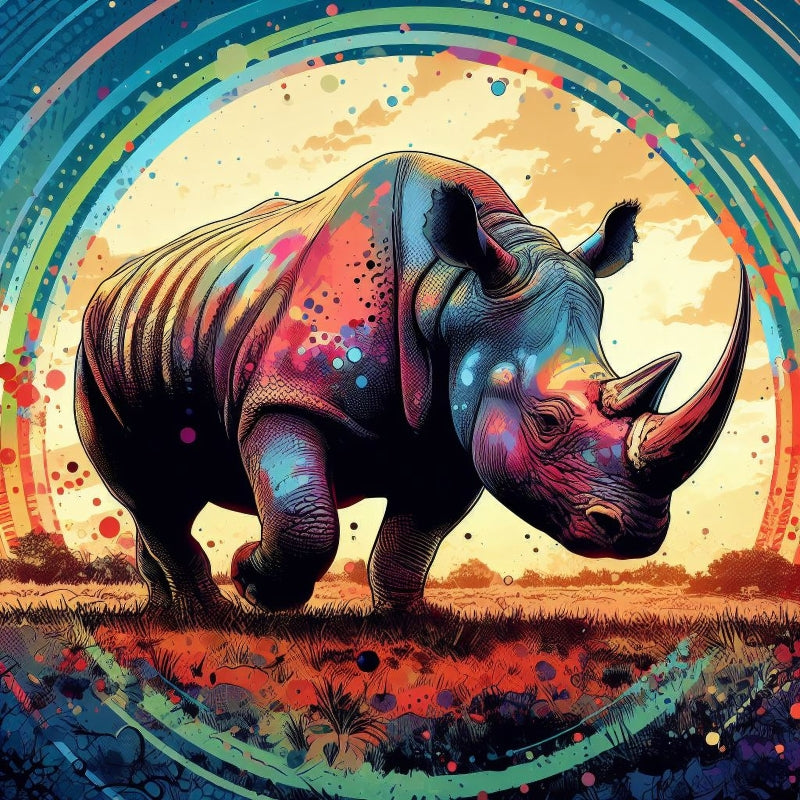
Significance of Rhinos in India: Historically and Culturally
Share
The Indian rhinoceros, also known as the greater one-horned rhinoceros (Rhinoceros unicornis), is a remarkable species native to the Indian subcontinent. Renowned for its distinctive appearance and cultural significance, the Indian rhino has garnered attention not only for its physical attributes but also for its historical and religious associations in the region. This blog post explores the significance of rhinos in India, delving into their historical roots, cultural importance, ecological roles, and conservation efforts.
- Historical Significance
The history of the Indian rhinoceros in India stretches back thousands of years. Ancient texts and artifacts reveal that rhinos have been part of Indian culture since prehistoric times. Evidence from cave paintings in regions like Madhya Pradesh suggests that early humans interacted with these magnificent creatures. In addition to artistic representations, rhinos are mentioned in ancient scriptures, including the Rigveda, where they are referred to as Khadga, symbolizing strength and power. The rhino's thick skin was often likened to armor, which has led to its association with warrior deities in Hindu mythology. This historical context underscores the deep-rooted connection between rhinos and Indian civilization.
- Cultural Symbolism
The Indian rhinoceros holds a prominent place in various cultural narratives across India. It is often associated with strength, resilience, and protection:
- Mythology: In Hindu mythology, the rhino is linked to several deities. For instance, Lord Krishna is said to have taken the form of a Varaha (boar) to rescue the Earth from submersion. Some interpretations suggest that this Varaha may have been inspired by the rhino's unique features.
- Folklore: Local folk tales often depict rhinos as powerful beings that embody nature's strength. In Tharu folklore, it is believed that the rhino was created by Lord Vishwakarma using parts from various animals, resulting in a creature that possesses both beauty and might.
- Art and Literature: The image of the Indian rhino has inspired countless works of art throughout history. From ancient sculptures to modern paintings, artists have celebrated this majestic animal as a symbol of India's rich wildlife heritage.
- Ecological Importance
Indian rhinoceroses play a vital role in maintaining ecological balance within their habitats:
- Grazing Impact: As herbivores that graze on grasses and browse on shrubs or trees, Indian rhinos help control plant growth within their ecosystems. Their feeding habits create open areas that benefit other herbivores by promoting diverse plant growth.
- Seed Dispersal: Rhinos contribute to seed dispersal through their dung; when they consume fruits or seeds from plants—these seeds germinate in nutrient-rich dung piles—facilitating plant regeneration within their ecosystems.
- Conservation Efforts
The plight of the Indian rhinoceros has spurred numerous conservation initiatives aimed at protecting this endangered species:
Project Rhino
Launched in 2005, Project Rhino aimed to increase the population of greater one-horned rhinoceroses across several protected areas in Assam. The initiative focused on relocating rhinos from overcrowded habitats like Kaziranga National Park to other suitable areas while enhancing protection measures against poaching. Through community engagement and collaboration with organizations like WWF-India and local government agencies, Project Rhino has successfully increased awareness about wildlife conservation while establishing a larger, safer population of Indian rhinos.
Protected Areas
Kaziranga National Park remains one of the most significant success stories in Indian rhino conservation. Once home to fewer than 200 individuals, Kaziranga now boasts over 2,400 greater one-horned rhinos, thanks to strict anti-poaching measures and habitat preservation efforts. The park's status as a UNESCO World Heritage Site underscores its ecological importance.
- Threats Facing Rhinos
Despite successful conservation efforts, Indian rhinoceroses continue to face numerous threats:
- Poaching: The demand for rhino horns in traditional medicine markets poses a significant threat to their survival. Poachers target these magnificent creatures for their horns, leading to drastic declines in populations.
- Habitat Loss: Urbanization and agricultural expansion have led to significant habitat destruction for many wildlife species. As forests are cleared for development or agriculture, these apex predators lose their natural habitats.
- Human-Wildlife Conflict: As human populations encroach upon rhino habitats; conflicts arise when these animals venture into agricultural fields or populated areas searching for food. This can lead to retaliatory killings by farmers seeking to protect their livelihoods.
- Cultural Reverence
In addition to their ecological significance, Indian rhinos hold cultural reverence among local communities:
- Community Engagement: Many indigenous communities view rhinos as sacred animals; they believe that harming them would bring misfortune or bad luck. This cultural reverence contributes to local conservation efforts aimed at protecting these majestic creatures.
- Traditional Practices: Some communities incorporate rituals celebrating the presence of rhinos within their territories; these practices foster respect for wildlife while promoting sustainable living.
- Rhinos as Icons of Peace
Indian rhinos have also become symbols of peace and reconciliation in regions recovering from conflict: In Assam's Manas National Park, reintroduction programs have helped restore populations while fostering positive relationships between local communities and wildlife. The presence of rhinos has brought pride back to communities healing from ethnic conflict; villagers embrace these animals as part of their cultural identity.
- Educational Importance
The Indian rhinoceros serves an educational purpose beyond its aesthetic appeal:
- Wildlife Education: Schools and educational programs use the rhino as a focal point for teaching students about biodiversity conservation and environmental stewardship. By learning about this national symbol, students gain an appreciation for wildlife protection efforts.
- Cultural Awareness: Understanding the significance of the rhino helps foster respect for India's diverse cultural heritage while promoting awareness about traditional practices that honor nature.
- International Recognition
The plight of Indian rhinoceroses has garnered international attention due to their endangered status:
- Conservation organizations worldwide collaborate with local governments and NGOs to address threats facing rhinos globally. Initiatives such as World Rhino Day celebrate these magnificent animals while raising awareness about conservation needs.
- Efforts are being made globally to combat poaching through stricter laws and increased enforcement. International cooperation is essential for protecting not only Indian rhinos but also all rhinoceros species facing similar threats across their ranges.
- Future Conservation Strategies
To ensure the long-term survival of Indian rhinoceroses requires ongoing commitment towards effective conservation strategies:
- Strengthening Protected Areas: Expanding existing protected areas while creating new ones can help secure crucial habitats for tigers. Effective management practices must be implemented within these reserves to ensure ecological integrity.
- Research and Monitoring: Ongoing research on tiger populations helps identify threats while informing effective management strategies. Utilizing advanced technology such as camera traps and GPS tracking can enhance monitoring efforts.
Conclusion
The significance of Indian rhinoceroses transcends their physical presence; they embody a rich tapestry of history, culture, spirituality, and ecological importance within India. Revered as symbols of strength and resilience across various traditions—rhinos continue to inspire awe among people from all walks of life.
Understanding why this magnificent animal holds such an esteemed place within our hearts encourages us all to take action towards ensuring its survival amidst growing threats posed by habitat loss or poaching. By fostering coexistence strategies that benefit both humans and wildlife alike—we can ensure future generations will continue marveling at these incredible beings roaming freely across our landscapes!
In celebrating this remarkable species—the great one-horned rhinoceros—let us commit ourselves not only to safeguarding its future but also ensuring that our cultural heritage remains intertwined with these majestic beings for years to come!
Citations:
[1] https://testbook.com/ias-preparation/indian-rhinoceros
[2] https://earthstoriez.com/india-nepal-there-be-unicorns-myth-folklore-of-the-one-horned-rhinoceros
[3] https://www.bbc.com/future/article/20220111-the-rhinos-bringing-peace-in-india
[4] https://www.homersphere.org/blog/rhinos-culture-colonialism-and-conservation
[5] https://www.kaziranganationalpark-india.com/blog/project-rhino-for-greater-one-horned-rhinoceros/
